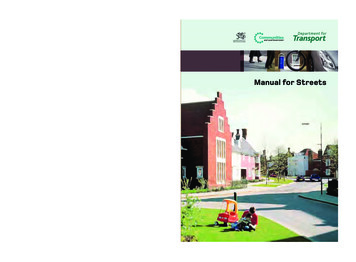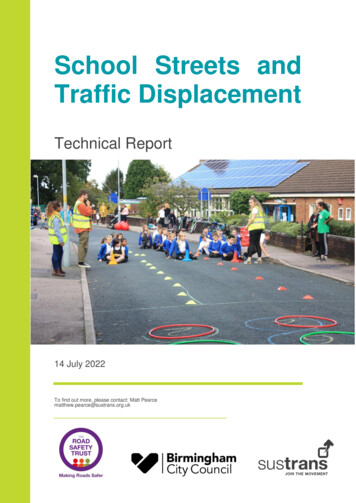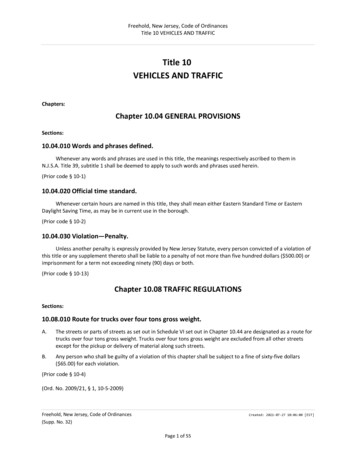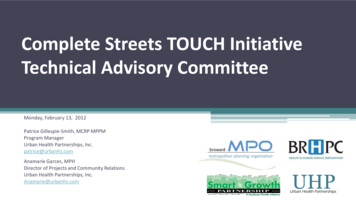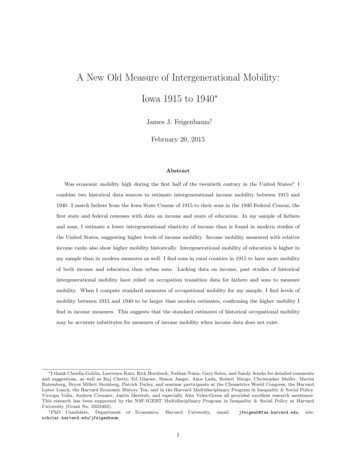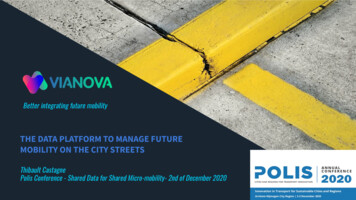
Transcription
Better integrating future mobilityTHE DATA PLATFORM TO MANAGE FUTUREMOBILITY ON THE CITY STREETSThibault CastagnePolis Conference - Shared Data for Shared Micro-mobility- 2nd of December 202011
AgendaLearnings for operators and city authorities from implementing micro-mobility management systemsin a range of European markets1 - Introduction about Vianova2 - Changing landscape & good practices3 - Presentation of Use cases2
How to better integrate future mobility on the city streetsChallenged public order, safety & city transitCities need data and efficient tools to supervise a range of mobility systems on the city streets3
1 - Vianova: a mobility platform for cities, built with cities-Enabling efficient share of public spacePromoting a safer & multi-modal transport systemShared mobilityRide-hailingTransport authoritiesMobility API(vehicles telemetry)Policy API(streets & curbs regulations)CitiesDeliveryPublic transport op.Micro- transitMobility Management web-dashboard4
1 - Sharing experience and good practices from EU citiesEspoo-Co-led a dozen of mobility data projects with European citiesHelsinkiStockholm-Set-up mobility management system and advised cities on dataanalysis and new mobility policies-Dedicated client support and project management capabilitiesBruxellesBaselClient organisation of Vianova:ZurichParisFaro5
2- Changing landscape: much better 2020 than 2019, 2018What we saw on the ground for the last 18 months:1.More maturity from cities: Data & Policies2.Cities are becoming the main client: PPP, tenders, permits, etc.3.Operators engaging in (very) constructive ways with cities: Data & Policies4.Cities are paying attention to each other ! Good ideas are being shared5.Data quality is significantly improving ! Nearly universal use of international formats (MDS, GBFS)6.Data privacy and understanding of GDPR is improving6
2 - Guidelines for shared-mobility management1.Develop their vision for shared (micro-) mobility as part of their Sustainable Urban Mobility Plan2.Set a regulatory framework that fit into that strategic visiona. Leave enough flexibility to adapt / add policiesb. Add data requirements: data quality, MDS data formatc. Include safety, sustainability and equity criteria3.Set clearly the purposes of data collection and communicate it well to operators within dataagreements4.Engage into a virtuous circle - micro-mobility management:a. Build: policiesb. Measure: control & analysisCity objectivesc. Learn: auditfulfilledDatainsightsMore suitablepolicies7
3 - Presentation of use cases8
Zurich: selecting mobility hubs & improving VBZ serviceEnabling multi-modal journeys through mobility hubs, and improving public transport servicePrioritise deployments of mobility hubsImprove quality of service & diminish wait timeETH universityWhen are the most micro-mobility tripsvs tram schedule9
Bruxelles: Deployments of 20 mobility hubsUsing pick-up & drop-off insights from shared vehicles to map & dimension mobility hubs gridVehiclestelemetriesMobilityinsightsUrban planningdecisions Monitoring of usageGare Bruxelles MidiGare Bruxelles Central10
Bruxelles: planning and usage of cycling lanesAccelerating micro-mobility post covid and ensuring safety of ridersCoronalane: Rue de la Loi (May)Coronalanes20 trips/ day in Feb900 trips/ day in July11
Stockholm: cluttered sidewalks & parking densityEasily spot streets with cluttered sidewalks and create specific parking infrastructure & policiesBirger JarlsgatanSpotting streets with high parking densityLink to citizens complaintsNormalised density of parked devices per street section Parking infrastructure (repurpose parking bay) No-parking policies on these streets12
Digitally expressed policies to operatorsReducing ambiguity and communication complexityPolicy Name : Bruxelles Plaisir d'hiverThe area of Plaine de Jeux Quai à laHouille will be forbidden to all"cyclo-partages" from 7am to 11pm thenext three weekends. The area will alsobe forbidden the following two days afterthe last weekend for cleaning efforts.Policy API13
Bruxelles: No-parking zones & violation notificationsImprove parking compliance of operators & shorten communication spanNo-parking zonesCompliance measurementGeographiesCompliance EngineCity policiesLive notification14
Fixing caps (or not) & requiring high quality of serviceAudit Equity: Fleet distribution in cities Policy: distribution requirementsAudit Performance: Vehicle rotation Policy: reduce/increase capsPerformance: Rotation 1.5Audit Quality of service: Fleet availability Policy: reduce/increase capsQuality of service: Fleet availability 10Equity: fleet distribution by district15
Key takeaways Enable data sharing with operators, privileging the MDS format for regulation & planning Comply with GDPR: purposes, data minimisation & retention, systems security Engage with a range of operators that could serve your city mobility objectives Use a micro-mobility management system, like Vianova.io, to control, regulate, plan and monitor Cost-efficient: development costs shared between 10-15 cities Experienced: GDPR compliance, data quality & policy management Transparent: Open-API Engage into a virtuous circle of Build-Measure-Learn Collaborative relationship with operators16
Thank you for listening & glad to answer any questionContact me for information:Thibault CastagneCofounder & CEO of Vianovathibault.castagne@vianova.io 33 6 17 87 49 21Paris, France Zurich, Switzerland17
- Set-up mobility management system and advised cities on data analysis and new mobility policies - Dedicated client support and project management capabilities. 2- Changing landscape: much better 2020 than 2019, 2018 What we saw on the ground for the last 18 months: 1. More maturity from cities: Data & Policies



